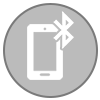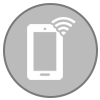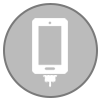Connecting Your Phone:
Because so much additional content is available through streaming data from the internet and because you may need to make and receive calls using your phone while you drive, getting the right connection between your phone and the system in your car is important. There are several considerations when choosing a connection: convenience, the ability to control phone apps from the touchscreen of the head unit and sound quality.
There are two basic ways to connect:
Wireless
For many people, the primary use of the phone while driving is for making and receiving phone calls. A Bluetooth connection makes that easy using the speakers in the car and a separate microphone. In a Bluetooth connection, the phone is paired with the car’s head unit over a wireless connection. Every subsequent time you enter the car, the phone and the head unit pair automatically. With Bluetooth, you will be alerted to an incoming call over the car’s speakers and you can answer, talk and hang up without having to hold the phone. Many factory-installed head units now include Bluetooth. If your car doesn’t include this feature, it can be added by replacing the radio or by adding a Bluetooth adapter designed specifically for connection to your existing head unit. That adapter isn’t available for every head unit. Ask us, we're the experts.
Bluetooth is available in aftermarket head units in nearly every price range. Many of the newer head units also include streaming of an audio signal from the phone to the head unit over Bluetooth when you aren’t using the phone to make or receive a call. You’ll also be able to control the track up and track down buttons to select the music to which you want to listen.
If you are mostly interested in streaming audio from your phone to your audio system over Bluetooth and don’t want to replace your head unit, consider a signal processor with a Bluetooth module if you are upgrading the rest of the audio system.
Finally, some newer aftermarket head units now offer onboard WiFi for connection to a WiFi hotspot (while parked at home) or one that you create in the car through your smartphone or a mobile hotspot. With this connection, you can access many media streaming services and internet sites and apps directly from the head unit.
A wireless connection between your phone and your car audio system has benefits and drawbacks when compared to a wired connection. A few of the drawbacks are that your phone won’t be charged while you drive and the connection quality between the phone and your car audio system may be of lower quality than you find acceptable. Finally, there are some features of the phone that you won’t be able to access over a wireless connection. Convenience is the major benefit of a wireless connection. You won’t have to remove our phone from your pocket, purse or briefcase in order to use some of the phone features while you drive. If you’re interested in basic features like making and receiving calls and streaming audio from your phone, a wireless connection may be right for you.
Wired
A wired connection is just what it sounds like—you’ll use a wire to connect the phone to the car’s system. If you just want to listen to audio files that are stored in your phone or streamed to your phone, the simplest connection is a basic audio connection using a 3.5mm cable that connects between the headphone output of your phone and the AUX input of the car’s system. This simple connection provides the best sound quality. In addition to the simple audio connection, you may also want to plug the phone into a power port using a cigarette lighter power adapter. This connection scheme is convenient, but it offers no ability to control the phone’s apps from the radio and doesn’t provide a safe way to make and receive phone calls “hands-free”, which is required in many states. It does, however, provide the best sound quality for listening to audio store in or streamed to the phone.
Another wired connection involves plugging the USB or Apple lightning connector directly into a head unit designed to provide this compatibility via USB. With this connection, the head unit will offer some set of controls over some apps on the phone as well as a high quality connection for music. This connection will also keep the phone charged while you drive. One such connection and control scheme is called Mirrorlink. Mirrorlink simply duplicates the display of your phone on the car’s head unit display screen. The apps still run on the phone, but you’re able to control them with the head unit’s touchscreen. With Mirrorlink, you can use your phone for navigation, to make and receive phone calls and to play media files. Other apps can be used too.
If you are an Apple or Android phone enthusiast, you may want to consider a new head unit that includes Apple’s CarPlay or Android Auto. Head units with these functions extend many of your favorite apps to the head unit, offering the ability to use the apps in a more convenient and appropriate way while you drive. You can explore the available features and compatible devices here:
If all of this sounds complicated
that’s because it is.
There are many options to consider and the most appropriate one depends on how you use your phone, the car in which you use it, the complexity of the audio system that’s already installed and your experience in using this kind of technology outside the car.






